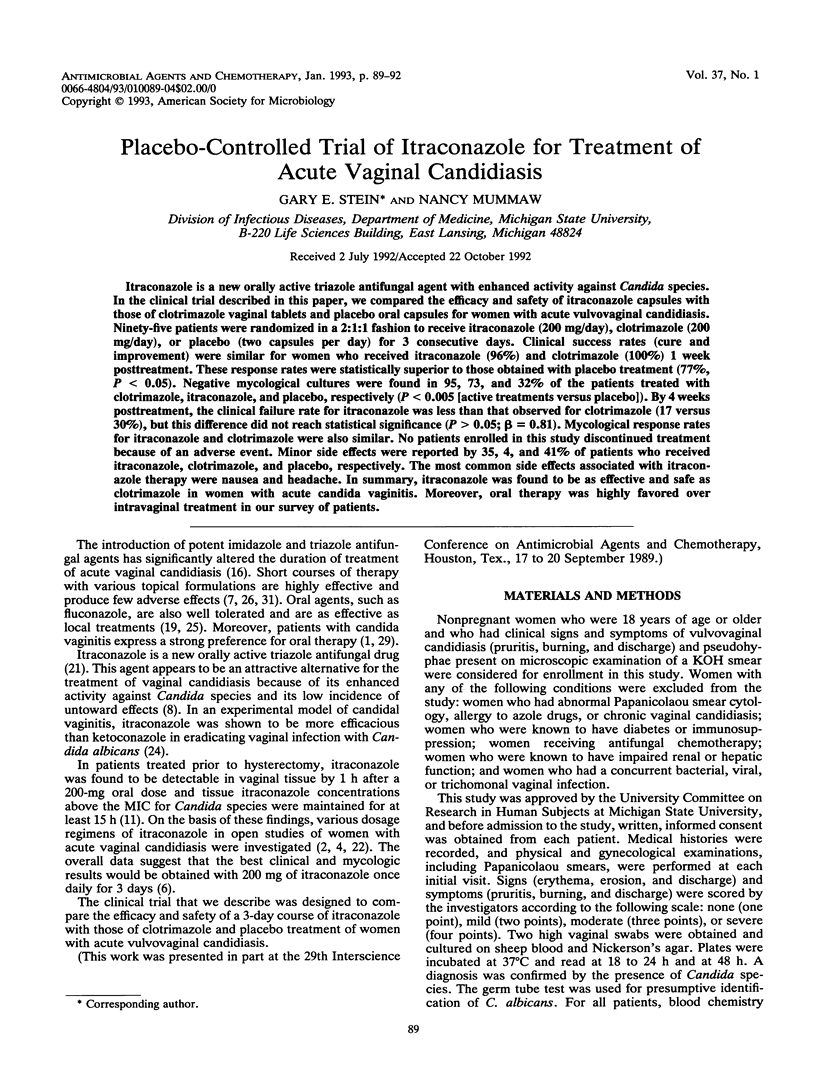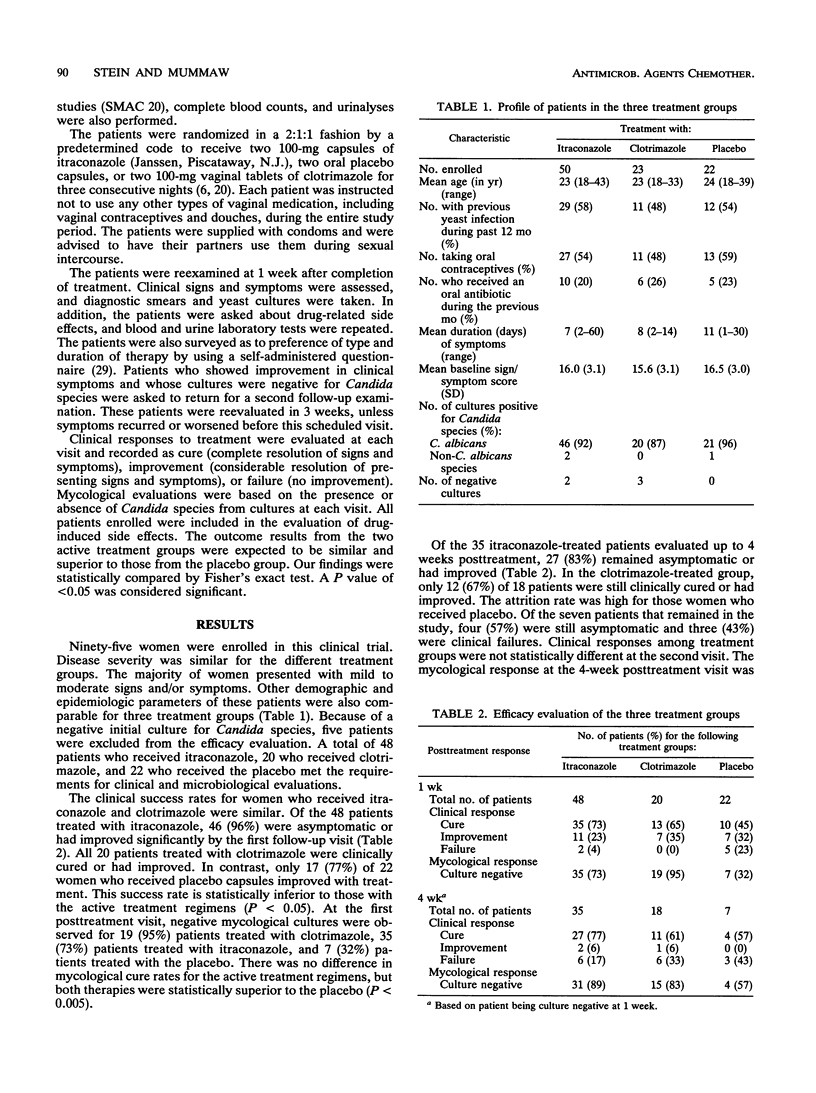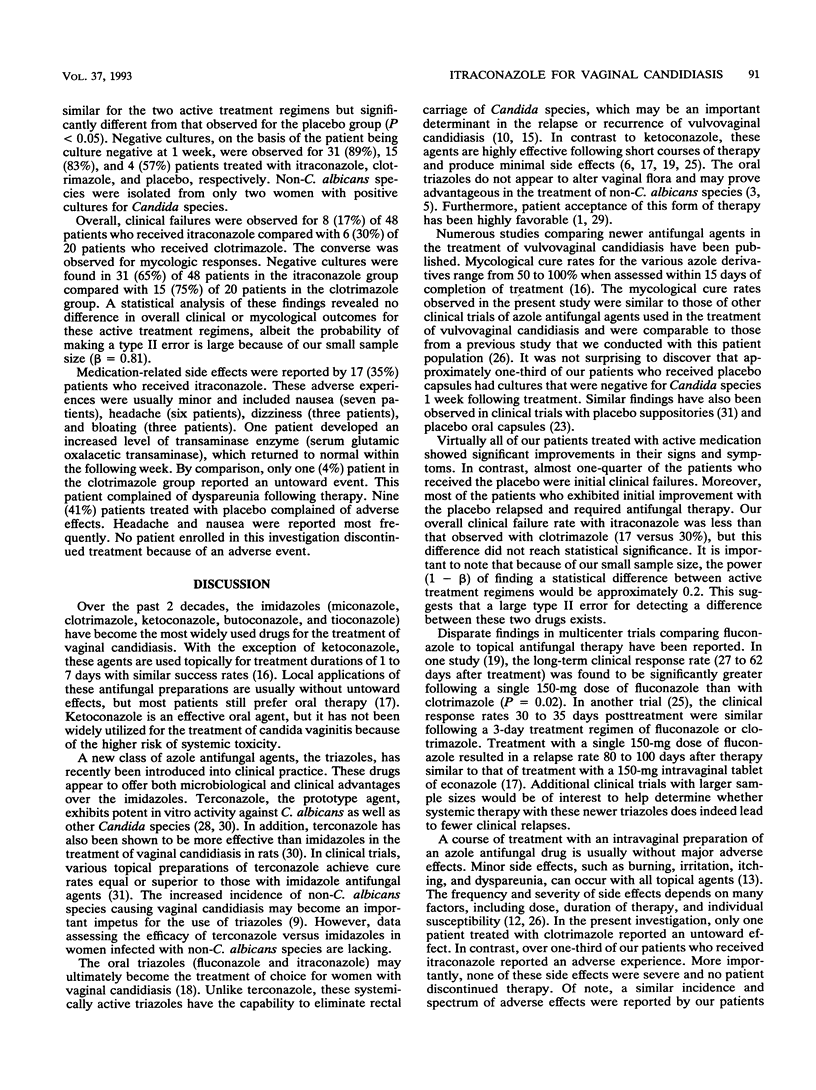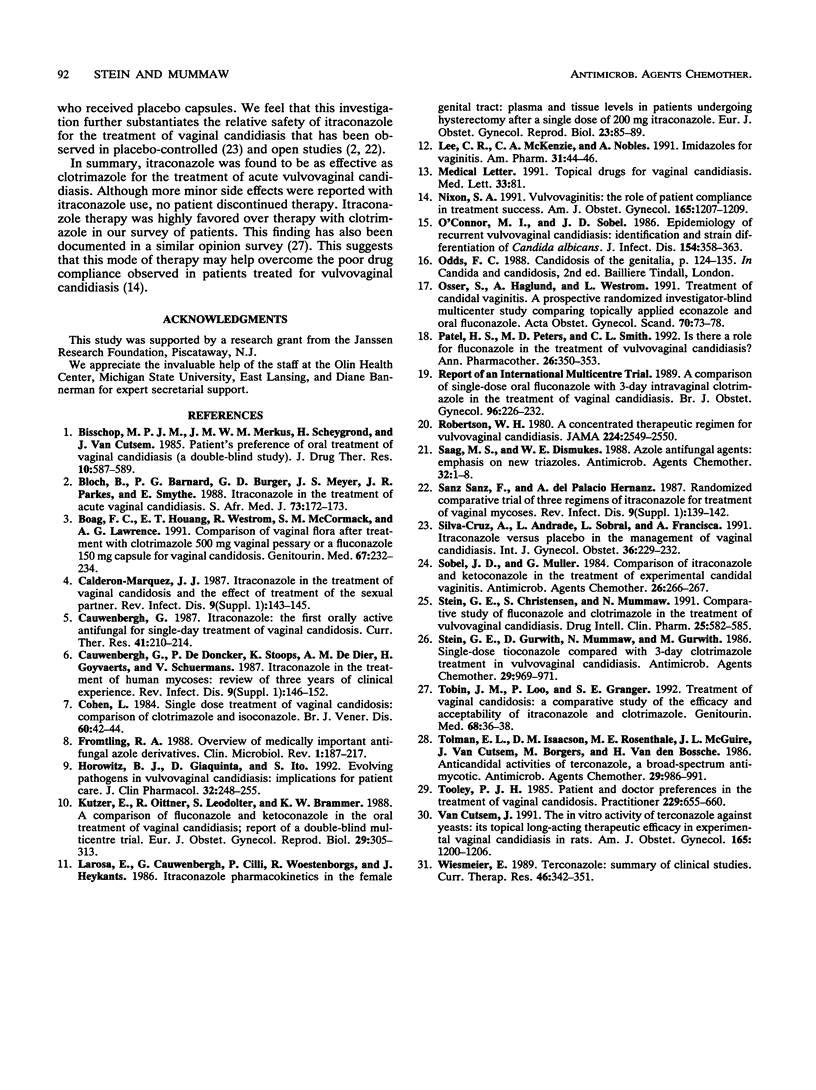Abstract
Itraconazole is a new orally active triazole antifungal agent with enhanced activity against Candida species. In the clinical trial described in this paper, we compared the efficacy and safety of itraconazole capsules with those of clotrimazole vaginal tablets and placebo oral capsules for women with acute vulvovaginal candidiasis. Ninety-five patients were randomized in a 2:1:1 fashion to receive itraconazole (200 mg/day), clotrimazole (200 mg/day), or placebo (two capsules per day) for 3 consecutive days. Clinical success rates (cure and improvement) were similar for women who received itraconazole (96%) and clotrimazole (100%) 1 week posttreatment. These response rates were statistically superior to those obtained with placebo treatment (77%, P < 0.05). Negative mycological cultures were found in 95, 73, and 32% of the patients treated with clotrimazole, itraconazole, and placebo, respectively (P < 0.005) [active treatments versus placebo]). By 4 weeks posttreatment, the clinical failure rate for itraconazole was less than that observed for clotrimazole (17 versus 30%), but this difference did not reach statistical significance (P > 0.05; beta = 0.81). Mycological response rates for itraconazole and clotrimazole were also similar. No patients enrolled in this study discontinued treatment because of an adverse event. Minor side effects were reported by 35, 4, and 41% of patients who received itraconazole, clotrimazole, and placebo, respectively. The most common side effects associated with itraconazole therapy were nausea and headache. In summary, itraconazole was found to be as effective and safe as clotrimazole in women with acute candida vaginitis. Moreover, oral therapy was highly favored over intravaginal treatment in our survey of patients.
Full text
PDF



Selected References
These references are in PubMed. This may not be the complete list of references from this article.
- Bloch B., Barnard P. G., Burger G. D., Meyer J. S., Parkes J. R., Smythe E. Itraconazole in the treatment of acute vaginal candidiasis. S Afr Med J. 1988 Feb 6;73(3):172–173. [PubMed] [Google Scholar]
- Boag F. C., Houang E. T., Westrom R., McCormack S. M., Lawrence A. G. Comparison of vaginal flora after treatment with a clotrimazole 500 mg vaginal pessary or a fluconazole 150 mg capsule for vaginal candidosis. Genitourin Med. 1991 Jun;67(3):232–234. doi: 10.1136/sti.67.3.232. [DOI] [PMC free article] [PubMed] [Google Scholar]
- Cohen L. Single dose treatment of vaginal candidosis: comparison of clotrimazole and isoconazole. Br J Vener Dis. 1984 Feb;60(1):42–44. doi: 10.1136/sti.60.1.42. [DOI] [PMC free article] [PubMed] [Google Scholar]
- Fromtling R. A. Overview of medically important antifungal azole derivatives. Clin Microbiol Rev. 1988 Apr;1(2):187–217. doi: 10.1128/cmr.1.2.187. [DOI] [PMC free article] [PubMed] [Google Scholar]
- Horowitz B. J., Giaquinta D., Ito S. Evolving pathogens in vulvovaginal candidiasis: implications for patient care. J Clin Pharmacol. 1992 Mar;32(3):248–255. doi: 10.1002/j.1552-4604.1992.tb03833.x. [DOI] [PubMed] [Google Scholar]
- Kutzer E., Oittner R., Leodolter S., Brammer K. W. A comparison of fluconazole and ketoconazole in the oral treatment of vaginal candidiasis; report of a double-blind multicentre trial. Eur J Obstet Gynecol Reprod Biol. 1988 Dec;29(4):305–313. doi: 10.1016/0028-2243(88)90071-8. [DOI] [PubMed] [Google Scholar]
- Larosa E., Cauwenbergh G., Cilli P., Woestenborghs R., Heykants J. Itraconazole pharmacokinetics in the female genital tract: plasma and tissue levels in patients undergoing hysterectomy after a single dose of 200 mg itraconazole. Eur J Obstet Gynecol Reprod Biol. 1986 Oct;23(1-2):85–89. doi: 10.1016/0028-2243(86)90109-7. [DOI] [PubMed] [Google Scholar]
- Lee C. R., McKenzie C. A., Nobles A. Imidazoles for vaginitis. Am Pharm. 1991 Jul;NS31(7):44–46. [PubMed] [Google Scholar]
- Nixon S. A. Vulvovaginitis: the role of patient compliance in treatment success. Am J Obstet Gynecol. 1991 Oct;165(4 Pt 2):1207–1209. doi: 10.1016/s0002-9378(12)90728-0. [DOI] [PubMed] [Google Scholar]
- O'Connor M. I., Sobel J. D. Epidemiology of recurrent vulvovaginal candidiasis: identification and strain differentiation of Candida albicans. J Infect Dis. 1986 Aug;154(2):358–363. doi: 10.1093/infdis/154.2.358. [DOI] [PubMed] [Google Scholar]
- Osser S., Haglund A., Weström L. Treatment of candidal vaginitis. A prospective randomized investigator-blind multicenter study comparing topically applied econazole with oral fluconazole. Acta Obstet Gynecol Scand. 1991;70(1):73–78. doi: 10.3109/00016349109006182. [DOI] [PubMed] [Google Scholar]
- Patel H. S., Peters M. D., 2nd, Smith C. L. Is there a role for fluconazole in the treatment of vulvovaginal candidiasis? Ann Pharmacother. 1992 Mar;26(3):350–353. doi: 10.1177/106002809202600309. [DOI] [PubMed] [Google Scholar]
- Robertson W. H. A concentrated therapeutic regimen for vulvovaginal candidiasis. JAMA. 1980 Dec 5;244(22):2549–2550. [PubMed] [Google Scholar]
- Saag M. S., Dismukes W. E. Azole antifungal agents: emphasis on new triazoles. Antimicrob Agents Chemother. 1988 Jan;32(1):1–8. doi: 10.1128/aac.32.1.1. [DOI] [PMC free article] [PubMed] [Google Scholar]
- Silva-Cruz A., Andrade L., Sobral L., Francisca A. Itraconazole versus placebo in the management of vaginal candidiasis. Int J Gynaecol Obstet. 1991 Nov;36(3):229–232. doi: 10.1016/0020-7292(91)90718-k. [DOI] [PubMed] [Google Scholar]
- Sobel J. D., Muller G. Comparison of itraconazole and ketoconazole in the treatment of experimental candidal vaginitis. Antimicrob Agents Chemother. 1984 Aug;26(2):266–267. doi: 10.1128/aac.26.2.266. [DOI] [PMC free article] [PubMed] [Google Scholar]
- Stein G. E., Christensen S., Mummaw N. Comparative study of fluconazole and clotrimazole in the treatment of vulvovaginal candidiasis. DICP. 1991 Jun;25(6):582–585. doi: 10.1177/106002809102500602. [DOI] [PubMed] [Google Scholar]
- Stein G. E., Gurwith D., Mummaw N., Gurwith M. Single-dose tioconazole compared with 3-day clotrimazole treatment in vulvovaginal candidiasis. Antimicrob Agents Chemother. 1986 Jun;29(6):969–971. doi: 10.1128/aac.29.6.969. [DOI] [PMC free article] [PubMed] [Google Scholar]
- Tobin J. M., Loo P., Granger S. E. Treatment of vaginal candidosis: a comparative study of the efficacy and acceptability of itraconazole and clotrimazole. Genitourin Med. 1992 Feb;68(1):36–38. doi: 10.1136/sti.68.1.36. [DOI] [PMC free article] [PubMed] [Google Scholar]
- Tolman E. L., Isaacson D. M., Rosenthale M. E., McGuire J. L., Van Cutsem J., Borgers M., Van den Bossche H. Anticandidal activities of terconazole, a broad-spectrum antimycotic. Antimicrob Agents Chemother. 1986 Jun;29(6):986–991. doi: 10.1128/aac.29.6.986. [DOI] [PMC free article] [PubMed] [Google Scholar]
- Tooley P. J. Patient and doctor preferences in the treatment of vaginal candidosis. Practitioner. 1985 Jul;229(1405):655–660. [PubMed] [Google Scholar]
- Van Cutsem J. The in vitro activity of terconazole against yeasts: its topical long-acting therapeutic efficacy in experimental vaginal candidiasis in rats. Am J Obstet Gynecol. 1991 Oct;165(4 Pt 2):1200–1206. doi: 10.1016/s0002-9378(12)90727-9. [DOI] [PubMed] [Google Scholar]


